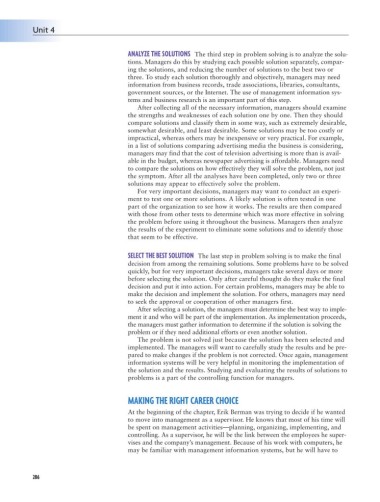Page 299 - Business Principles and Management
P. 299
Unit 4
ANALYZE THE SOLUTIONS The third step in problem solving is to analyze the solu-
tions. Managers do this by studying each possible solution separately, compar-
ing the solutions, and reducing the number of solutions to the best two or
three. To study each solution thoroughly and objectively, managers may need
information from business records, trade associations, libraries, consultants,
government sources, or the Internet. The use of management information sys-
tems and business research is an important part of this step.
After collecting all of the necessary information, managers should examine
the strengths and weaknesses of each solution one by one. Then they should
compare solutions and classify them in some way, such as extremely desirable,
somewhat desirable, and least desirable. Some solutions may be too costly or
impractical, whereas others may be inexpensive or very practical. For example,
in a list of solutions comparing advertising media the business is considering,
managers may find that the cost of television advertising is more than is avail-
able in the budget, whereas newspaper advertising is affordable. Managers need
to compare the solutions on how effectively they will solve the problem, not just
the symptom. After all the analyses have been completed, only two or three
solutions may appear to effectively solve the problem.
For very important decisions, managers may want to conduct an experi-
ment to test one or more solutions. A likely solution is often tested in one
part of the organization to see how it works. The results are then compared
with those from other tests to determine which was more effective in solving
the problem before using it throughout the business. Managers then analyze
the results of the experiment to eliminate some solutions and to identify those
that seem to be effective.
SELECT THE BEST SOLUTION The last step in problem solving is to make the final
decision from among the remaining solutions. Some problems have to be solved
quickly, but for very important decisions, managers take several days or more
before selecting the solution. Only after careful thought do they make the final
decision and put it into action. For certain problems, managers may be able to
make the decision and implement the solution. For others, managers may need
to seek the approval or cooperation of other managers first.
After selecting a solution, the managers must determine the best way to imple-
ment it and who will be part of the implementation. As implementation proceeds,
the managers must gather information to determine if the solution is solving the
problem or if they need additional efforts or even another solution.
The problem is not solved just because the solution has been selected and
implemented. The managers will want to carefully study the results and be pre-
pared to make changes if the problem is not corrected. Once again, management
information systems will be very helpful in monitoring the implementation of
the solution and the results. Studying and evaluating the results of solutions to
problems is a part of the controlling function for managers.
MAKING THE RIGHT CAREER CHOICE
At the beginning of the chapter, Erik Berman was trying to decide if he wanted
to move into management as a supervisor. He knows that most of his time will
be spent on management activities—planning, organizing, implementing, and
controlling. As a supervisor, he will be the link between the employees he super-
vises and the company’s management. Because of his work with computers, he
may be familiar with management information systems, but he will have to
286

